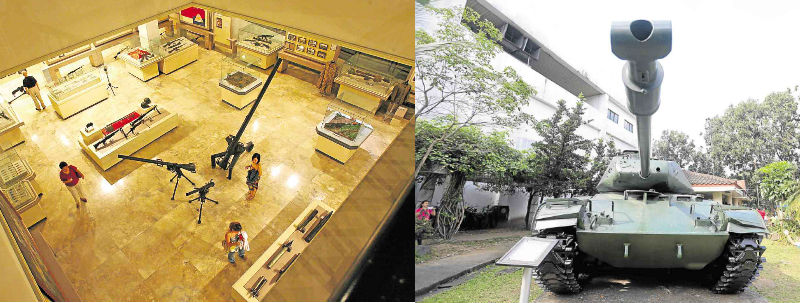AFP threatens to cut power to museum

COME tomorrow, the AFP Museum inside Camp Aguinaldo may be forced to shut its doors for lack of electricity, putting its artifacts, including a 1950s “Walker Bulldog” tank (right) used by the Army during the Cold War which is on permanent display outside the museum, in danger of falling apart due to neglect. LYN RILLON, RAFFY LERMA
THE KEEPER of the Armed Forces of the Philippines’ (AFP) historical artifacts—including the “rayadillo” uniform worn in battle by Gen. Emilio Aguinaldo and Apolinario Mabini’s handwritten letters—is in danger of being shut down due to over P1.37 million in outstanding electrical bills.
The amount, AFP Museum administrator Elizabeth Dapiton told the Inquirer, represents the facility’s unpaid balance between November 2013 and December 2015.
Dapiton said that they received a disconnection notice from the AFP on Jan. 27, informing them that they have just five days to settle their obligation.
“It’s a notice of disconnection but the tone is a demand letter, stating: ‘Please be informed that you are given five working days from receipt of this notice to pay the amount of P1.3 million representing unpaid electricity account. If you fail to pay the whole amount within the prescribed period, the command will disconnect your electricity connection on Feb. 3, 2016,’” she said, reading the letter from the Office of the Non-Appropriated Funds of the AFP.
The AFP museum is located at the Gen. Arturo Enrile building at Camp Aguinaldo, the AFP main headquarters in Quezon City. Established in 1996, it is dedicated to the preservation, conservation and promotion of the Armed Forces’ military traditions, culture and history.
Article continues after this advertisementIts outdoor display consists of various equipment used by the different AFP branches such as old airplanes and tanks. The indoor exhibit showcases dioramas featuring vintage weaponry and other military hardware, field uniforms, plus documents and photographs that retrace the evolution of Philippine soldiery since pre-colonial times.
Article continues after this advertisementDapiton explained that when the museum was established, there was a verbal agreement that the AFP would be subsidizing its utility expenses.
But in November 2013, the AFP began billing the museum for its electrical consumption averaging between P45,000 and P50,000 a month.
“They knew from the start that this is a nonstock, nonprofit private foundation; it is not for profit so we don’t have the means to pay for our utilities,” Dapiton said.
She explained that all concessionaires inside Camp Aguinaldo were being billed for their utility expenses and that the museum was probably considered a concessionaire or tenant since it was operating on AFP property.
The museum itself is under the AFP Museum and Historical Library Foundation Inc.
“It is not directly under the AFP though this was established basically for the AFP. Their collection is being kept here; we are a repository of the collections of the AFP and in a way, we are giving the AFP a good image,” Dapiton said.
Museum consultant Jose Custodio, on the other hand, said that the museum encourages visitors, mostly students, to join the military.
“Imagine the value for money there. This museum is like a recruitment center for the students. That’s the effect and they [AFP] don’t see it. I can cite so many positive things that the AFP gets from this setup and yet here we are,” Custodio added.
Dapiton explained that the museum has been unable to pay its monthly electricity bills since November 2013 since it is dependent on the dividend income it gets from its capital endowment fund and cash donation for specific projects.
The Philippine Veterans Affairs Office, for example, regularly supports the museum’s specific projects while employees’ salaries and maintenance expenses are covered by the dividend income.
For tours, the museum has charged P10 per student until two years ago when the fee was raised to P20. Dapiton, however, noted that the increase in fees was still not enough.
“We are still grateful to the AFP because if they started billing us a long, long time ago, we would have closed down so we still owe that to them,” she said.
She added that last year, they wrote the camp commander, asking for enough time to raise the money needed to pay the museum’s electricity bill. Based on a verbal agreement, both sides agreed that payment would be deferred until further notice.
For 2014, the museum’s income reached P369,722.25 from admission fees in addition to P37,041 in donations for a total of P406,763.25 in funds.
On the other hand, the museum’s expenses, minus the electricity bill, was P1,151,731.82.
Dapiton expressed concern on whether they would still be able to accept visitors or be forced to shut down should the electricity be cut off starting Feb. 3.
She wrote the AFP to inform them that Rep. Gary Alejano has a scheduled activity on Feb. 11 at the museum—a prayer memorial service for the victims of World War II.
The guest speaker for the event is the AFP Chief of Staff himself, Gen. Hernando Iriberri, while PVAO administrator Ernesto Carolina will also be one of the guests.
“Are we to accept visitors or not; are we closing down? Because if we are to base this on the notice, we [will be] closed by Feb. 3 since we [won’t] have electricity anymore,” Dapiton said.
She recalled that in 2007, the museum was in a similar predicament after its transformers bogged down.
“You can smell the molds and fungi at the lobby at that time. It was so dark [since] the building was constructed with no windows,” Dapiton said.